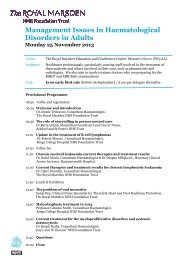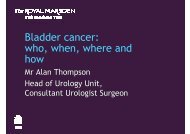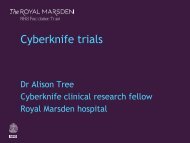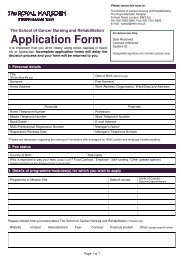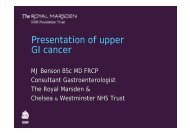Central Venous Access Devices - The Royal Marsden
Central Venous Access Devices - The Royal Marsden
Central Venous Access Devices - The Royal Marsden
Create successful ePaper yourself
Turn your PDF publications into a flip-book with our unique Google optimized e-Paper software.
In what circumstances should I contact the hospital?Contact the hospital immediately if you notice any of the following:• You develop a high temperature, fever, chills or flu likesymptoms (this could be an infection) – refer to your alert card.• Your arm, neck or shoulder is swollen and painful (this could bea sign of a blood clot).• You have pain or burning when flushing the catheter.• You can’t flush your catheter easily without resistance – thiscould indicate that the catheter has become blocked (never useforce when flushing the catheter).• Your catheter is cracked or broken (fold/clamp the tubing andtape it securely).• Your catheter is pulled out – which may mean the tip of thecatheter is not in the correct position.• You think your catheter site looks red and inflamed, there is anydischarge or the redness is tracking up your arm from your PICC(after the first week) – could be early signs of infection.• Your PICC is leaking under the dressing.• Your PICC is partially pulled out (that is the amount of exposedcatheter is more than ______cm). Do not attempt to push it backin.18






